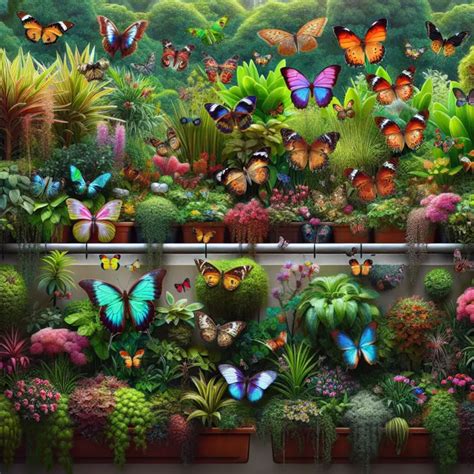Effective Ways to Attract Butterflies to Your Balcony Garden
Urban gardening enthusiasts are constantly searching for innovative ways to create beautiful and functional outdoor spaces, even in small areas like balconies. Butterflies, with their vibrant colors and delicate grace, can enhance any balcony garden. These pollinators not only add visual appeal but also help foster biodiversity and promote plant health. But how do you turn a modest container garden into a butterfly-friendly haven? This article explores essential strategies to attract butterflies to your balcony garden, combining practical tips and scientific insights for achieving a flourishing and sustainable environment.
Key Concepts for Attracting Butterflies
- Pollinator-friendly plants: Specific plant species that provide nectar and shelter for butterflies.
- Urban gardening: Creating green spaces in densely populated areas, such as balconies and rooftops.
- Container gardening: Growing plants in pots and containers, essential for small spaces.
- Biodiversity: The variety of plant and animal life in a particular habitat, contributing to ecological balance.
- Seasonal plants: Choosing plants that thrive during different seasons, providing year-round sustenance for butterflies.
Historical Context of Balcony and Urban Gardening
Balcony gardening is not a new trend. It dates back to ancient civilizations like the Romans, who cultivated small gardens in confined spaces. As cities expanded during the Industrial Revolution, urbanization reduced access to traditional gardens. Yet, people found ways to incorporate nature into their living spaces, leading to a resurgence in urban gardening. Today, with growing environmental awareness, people recognize the importance of fostering biodiversity in even the smallest urban spaces, such as balcony gardens.
Current State Analysis of Butterfly Populations and Urban Gardens
Butterfly populations have been declining globally due to habitat loss, pollution, and the widespread use of pesticides. Urbanization contributes to this, but balcony and container gardens offer a practical solution to help attract butterflies and other pollinators. While urban spaces lack the vast meadows and forests that butterflies typically prefer, they can still serve as vital refuges for species struggling to find habitats. Strategically incorporating native and pollinator-friendly plants can make a significant impact.
Practical Applications: How to Create a Butterfly-Friendly Balcony Garden
- Choose Native Plants: Butterflies are drawn to plants native to your region, as they have evolved alongside them. Examples include milkweed for Monarch butterflies.
- Provide Nectar and Host Plants: Nectar-rich flowers like lavender and daisies provide food, while host plants such as parsley cater to caterpillar development.
- Create Layers of Vegetation: A variety of plant heights and types can mimic a natural habitat, giving butterflies more places to shelter and feed.
- Use Organic Fertilizers and Pesticides: Harsh chemicals repel butterflies and harm their populations. Opt for natural alternatives to maintain an eco-friendly space.
- Water Source: Butterflies need water, but not in large quantities. A shallow dish with rocks allows them to drink without drowning.
- Sunny Spots: Butterflies love sunbathing, so ensure parts of your balcony receive ample sunlight.
Case Studies of Successful Butterfly Gardens in Urban Settings
| Case Study | City | Key Features | Outcome |
|---|---|---|---|
| Apartment Garden in Chicago | Chicago | Native milkweed, lavender, small water dish | Attracted Monarchs and Swallowtails |
| Rooftop Garden in New York | New York City | Multiple container plants, organic soil | Increased butterfly sightings, improved local biodiversity |
| Balcony Garden in London | London | Seasonal flowers, limited pesticide use | Sustained butterfly population throughout summer |
Stakeholder Analysis
Various stakeholders benefit from efforts to attract butterflies in urban settings. Residents enjoy the aesthetic and environmental benefits, while city planners and environmental organizations see urban gardening as a way to combat biodiversity loss. Furthermore, environmentalists can use these gardens to promote eco-friendly practices and raise awareness about butterfly conservation. Butterfly species themselves are major stakeholders, as these gardens offer much-needed sanctuaries in urban areas.
Implementation Guidelines
- Plan Your Layout: Assess your balcony’s sun exposure and space availability before choosing plants.
- Start Small: Begin with a few native species to observe how they thrive before expanding.
- Use Vertical Space: Incorporate hanging pots or vertical plant stands to maximize available area.
- Minimize Chemical Use: Emphasize organic practices to support butterfly populations.
- Monitor and Adjust: Track butterfly activity and adjust your plant selection based on what attracts them the most.
Ethical Considerations
While creating butterfly-friendly spaces is beneficial, gardeners must consider the broader environmental impact of their choices. For example, introducing non-native species could unintentionally harm local ecosystems. Gardeners should prioritize plants that are regionally appropriate and avoid invasive species that could outcompete native flora. Additionally, while promoting biodiversity, it’s essential to balance the needs of human urban development with natural ecosystems.
Limitations and Future Research
One of the limitations of urban butterfly gardening is the small scale of these efforts. While individual gardens may attract butterflies, large-scale urban planning is required to create interconnected habitats that support sustained butterfly populations. Additionally, more research is needed on which plants work best in urban environments and how they interact with different butterfly species. Finally, future research should investigate how climate change is impacting both urban gardening and butterfly migratory patterns.
Expert Commentary
Experts agree that urban gardens can significantly benefit butterfly conservation efforts. According to Dr. Linda Gonzalez, a specialist in urban ecology, “Even small balcony gardens can act as critical patches of habitat, especially in densely populated areas where butterflies have few natural spaces left.” Another expert, horticulturist Jim Woods, emphasizes the importance of native plants: “Choosing the right plants is key. A simple switch to native species can turn a balcony from a decorative space into a thriving butterfly habitat.”


